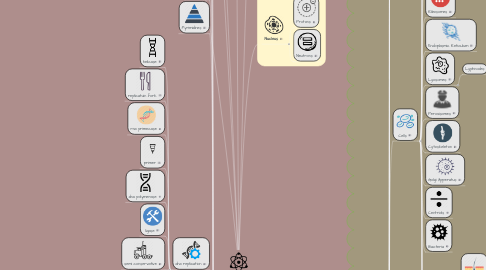
1. Carbon Cycle
1.1. Atmosphere filled with C02
1.2. Photosynthesis
1.3. Death and Decay
1.4. Combustion
1.4.1. Carbon Dioxide
1.4.1.1. Carbon Footprint
1.4.1.2. Green Houses
1.4.1.3. Green Energy
1.4.2. Global Warming
1.4.2.1. Ocean Acidification
1.4.2.2. Polar Ice Caps
1.4.2.3. Solar Power
1.4.2.4. Wind Power
1.5. Resparation
2. Water Cycle
2.1. Percipitation
2.2. Evaporation
2.3. Transpiration
2.4. Run Off
2.5. Seepage
2.6. Rootuptake
3. Water
3.1. pH Scale
3.1.1. Acids vs Bases
3.2. Hydrogen Bonding
3.2.1. Convalent Bond
3.2.2. Ionic Bond
3.2.3. Double/Triple Bonds
3.2.4. Hydrophobic
3.2.5. Hydrphillic
3.3. Cohesion
3.4. Adhesion
3.5. Polarity
4. Element
4.1. monecule
4.1.1. Compound
4.1.1.1. carbohydrates
4.1.1.1.1. Saccharieds
4.1.1.2. Protein
4.1.1.2.1. Amino Acids
4.1.1.2.2. Enzymes
4.1.1.3. Polymers
4.1.1.4. Saccharides
4.1.1.4.1. Activation Energy
4.1.1.5. Lipids and Fats
4.1.1.5.1. Fatty Acids
4.1.1.6. Reactants
4.1.1.6.1. Solutes in Solutions
4.1.1.7. Products
4.1.1.7.1. Solvents in solutions
4.1.1.8. Functional Groups
4.1.2. Monomers
4.2. Carbon
4.2.1. Double/Triple bonds
4.2.2. Functional Group
4.3. Atomic Number
4.4. Periodic Table of Elements
4.5. Oxygen
4.6. C02
4.7. Water
4.7.1. Glycolysis
4.7.1.1. Pruviric Acid
4.7.1.2. Fermentation
4.7.1.2.1. Lactic Acid Fermebtation
4.7.1.2.2. Cheese/ Dairy products
4.7.1.2.3. Alcohol Products
4.7.1.2.4. Yeast
5. DNA
5.1. Double Helix
5.2. Nucleotide
5.2.1. Adenine'
5.2.2. Cytosine
5.2.3. gaunine
5.2.4. thymine
5.3. Deoxyribose
5.4. Phosphate
5.5. Nitrogenous Base
5.6. Purines
5.7. Pyrimidines
5.8. dna replication
5.8.1. helicase
5.8.2. replicatuin fork
5.8.3. rna primecase
5.8.4. primer
5.8.5. dna polymerase
5.8.6. ligase
5.8.7. semi conservative
5.8.8. replication
5.8.9. leading strand
5.8.10. lagging strand
5.8.11. leading strand
5.8.12. dna mutations
5.8.13. cancer
5.9. complemetery stand
5.10. Gene
5.10.1. Dominant factor
5.10.1.1. Recessive factor
5.10.2. Law of segregation
5.10.3. Law of independent assortment
5.10.4. Dominant allele
5.10.5. Recessive allele
5.10.6. Genotype
5.10.7. Phenotype
5.11. chromosmes
5.11.1. Histones
5.11.2. Chromatin
5.11.3. Homolygus chromosomes
5.11.3.1. Homozygus dom
5.11.3.2. Homozygus recessive
5.11.3.3. Heterozygus
5.11.3.4. Monohybrid cross
5.11.3.4.1. Punnet square
5.11.4. Sex chromosomes
5.11.4.1. X chromosome
5.11.4.2. Y chromosomes
5.11.5. Karyotype
5.11.6. Haploid
5.11.7. Diploid
5.11.8. Mitosis
5.11.8.1. Interphase
5.11.8.1.1. G1
5.11.8.1.2. S
5.11.8.1.3. G2
5.11.8.2. Prophase
5.11.8.3. Metaphase
5.11.8.3.1. Metaphase plate
5.11.8.4. Anaphase
5.11.8.5. Telophase
5.11.8.6. Cytokinesis
5.11.8.6.1. Clevage Furrow
5.11.8.7. Centrosomes
5.11.8.7.1. Spindle Fibers
5.11.8.8. Cell plate
5.11.9. Mieosis 1 and 2
5.11.9.1. Prophase 1 and 2
5.11.9.1.1. Synapsis
5.11.9.2. Metaphase 1 and 2
5.11.9.2.1. Crossing over
5.11.9.3. Anaphase 1 and 2
5.11.9.4. Telophase 1 and 2
5.11.9.5. Cytokinesis 1 and 2
5.11.9.6. Gametes
5.11.9.6.1. Sperm cells
5.11.9.6.2. Egg Cells
5.11.9.6.3. Zygote
5.11.10. Trait
5.12. Binary Fussion
5.13. Characteristic
5.14. Heretible feature
6. RNA
6.1. Ribose
6.2. Uracil
6.3. Single Starded
6.4. Transcription
6.4.1. Terminal Signal
6.4.2. mRNA
6.5. Promoter
6.6. RNA Polymerase
6.7. Translation
6.7.1. Initiation
6.7.2. Elongation
6.7.3. Termination
6.7.4. Codon table
6.7.4.1. Codons
6.7.4.1.1. Stopcodon
6.7.5. rRNA
6.7.6. tRNA
6.7.6.1. Anti-codons
7. Nucleus
7.1. Protons
7.2. Neutrons
8. Electrons
9. Mass
9.1. Matter
9.1.1. Atoms in a Solid
9.1.2. Atoms in a Liquid
9.1.3. Atoms in a Gas
9.1.4. Heat and Energy
10. Organism
10.1. Population
10.1.1. Community
10.1.1.1. Ecosystem
10.1.1.1.1. Biome
10.1.1.1.2. Biotic Factor
10.1.1.1.3. Abiotic Factor
10.1.1.2. Interdependence
10.2. Conformers
10.2.1. Migration
10.2.2. Hibernation
10.3. Regulators
10.4. Producers
10.5. Herbavoirs
10.6. Carnivorous
10.7. Omnivoirs
10.8. Detrivitiors
10.9. Energy Pryamid
10.9.1. Kcal
10.10. Cells
10.10.1. Celll Theroy
10.10.1.1. Cellular Basis for Life
10.10.1.2. Cell Size
10.10.2. Plasma Membrane
10.10.3. Cytoplasm
10.10.4. Prokaryotes
10.10.5. Eukaryotes
10.10.6. Tissues
10.10.6.1. Organs
10.10.6.1.1. Organ System
10.10.7. Mitochondria
10.10.8. Ribosomes
10.10.9. Endoplasmic Reticulum
10.10.10. Lyosomes
10.10.10.1. Lyphnodes
10.10.11. Peroxisomes
10.10.12. Cytoskeleton
10.10.13. Golgi Apperatus
10.10.14. Centriols
10.10.15. Bacteria
10.10.16. Skin cells
10.10.16.1. Epidermil
10.10.16.2. Mesodermal
10.10.16.3. Endothermal
10.10.17. Mucus
10.10.18. WBCs
10.10.19. Phagocyte
10.10.20. Histamine
10.10.21. Anti-histamiines
10.10.22. B-cells
10.10.22.1. Memory cells
10.10.22.1.1. Vaccines
10.11. Colonial Organism
10.12. Heterotrophs
10.13. Autotrophs
10.13.1. Leaf
10.13.2. Plant Cells
10.13.2.1. Chloroplast
10.13.2.2. Granam
10.13.2.3. Thylakoid
10.13.2.4. Chlorophyll A/B
10.13.2.5. Cartenoids
10.13.3. Photosytesis Equation
10.13.3.1. Light Reaction Cycle
10.13.3.1.1. Pigments
10.13.3.2. Photosystem 1 and 2
10.13.3.3. Calvin Cycle
10.13.3.3.1. Oxygen
10.13.3.3.2. C02
10.13.3.4. C3C4CAM
10.13.4. Stroma
10.13.4.1. Atp Synthase
10.13.4.1.1. Stromata
10.13.5. Chesmosis
10.13.6. Anther
10.13.6.1. Pollen
10.13.7. Stigma
10.13.8. Seeds
10.13.9. Self pollination
10.13.10. Cross Pollination
10.13.11. True breeding
10.13.11.1. P generation
10.13.11.1.1. F1 generation
10.13.12. Hybrids
10.14. Cellular reperation equation
10.14.1. ATP
10.15. James Watson and Francis Crick
10.16. Gregor Mendal
10.17. Virus
10.17.1. Virus head
10.17.1.1. Virus DNA
10.17.2. Virus Legs
10.17.3. Allergies
10.18. Cilla
10.19. Saliva
10.20. Stomach acid
10.20.1. Stoamch ulcer
10.21. T-cells
10.22. Pryogens
10.22.1. Antibodies
10.22.1.1. Antigen
